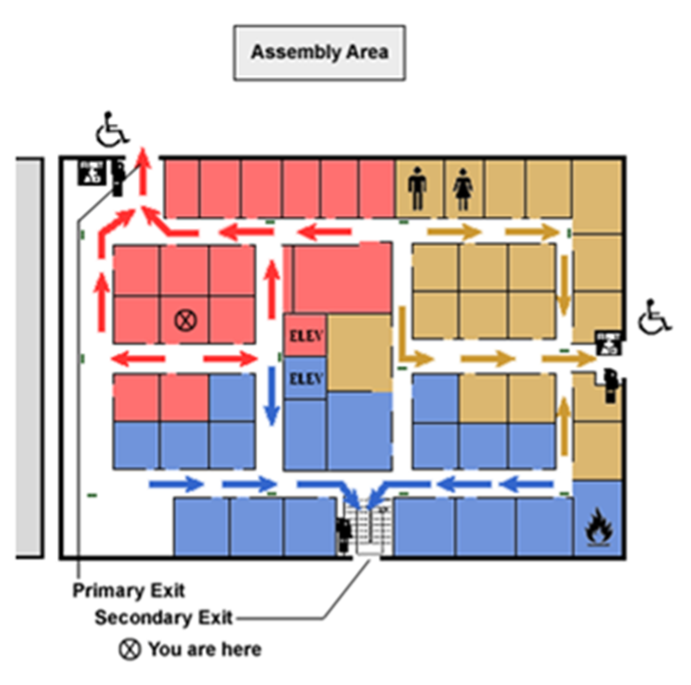- Many industries have one or more hazardous gases in their facilities, and they must prepare evacuation plans for hazardous gases in case of leaks or fires.
- Effective evacuations during emergencies depend on prior planning and training and following well-defined protocols.
- Both employers and employees have crucial roles before and during evacuations.
Comprehensive safety protocols for industrial gas leaks include prevention, detection, and response to protect workers, facilities, neighborhoods, and the environment. Emergency evacuations are crucial for safeguarding staff and are more common than anticipated, so safety managers should prepare their facilities. This article provides basic information on ensuring safe evacuations. However, the procedure must be customized for site-specific evacuations that meet national standards.
Emergency Evacuation Plans
Emergency evacuation involves people moving away immediately from an actual leak or hazard.
Emergency evacuations start with developing evacuation plans, including communication protocols to inform staff of dangers. This is followed by response or evacuations and then first aid measures.
Developing Evacuation Plans: In the USA, businesses must build emergency evacuation and fire prevention plans according to the Occupational Safety and Health Administration’s (OSHA) 29 CFR 1910.38 regulations. Companies must undertake risk assessments to identify potential hazardous gases in their premises as raw materials or produced as byproducts.
Communication Systems: Each facility must have effective ways to alert and instruct staff about an emergency occurring or pending. These include audio and visual alarms, public announcement (PA) systems, and texts.
Training and Education: The staff must be educated on implementing safe evacuations after developing safety protocols. The staff must be trained appropriately through drills in using route equipment, recognizing toxicity symptoms, and making decisions.
Creating an Emergency Action Plan
The various hazardous gases in a facility can be toxic, inert, or combustible and will vary depending on the business. Safety managers must prepare an evacuation plan for hazardous gases, considering the properties of all hazardous gases in their facilities.

Figure 1: “Example Evacuation Floor Diagram,” OSHA. (Image credits: https://www.osha.gov/emergency-preparedness/getting-started#v-nav-evacuation)
The emergency plans must respond to specific hazards. According to OSHA, some factors that must be considered while making evacuation plans are as follows:
- A proper chain of command is essential, where trained officers/supervisors with authority can order evacuations, shut down work machinery, and guide the process. In extensive facilities, more than one person may need to be in charge of evacuation to help in various departments. Other workers must know who is in charge in case of emergencies.
- The evacuation policy must be easy to follow.
- Include specific routes and exits to be followed during evacuation. Assign an area outside where people should assemble after evacuation; see Figure 1.
- Have procedures with assigned and well-trained employees who will stay behind to contain the hazards, like shutting down gas pipes or electricity.
- Make provisions for effective communication during and after emergencies.
- Select and train people to give first aid and CPR, and allot stations for these tasks. Plan for carbon monoxide poisoning in case of fires.
- Local authorities may not have the expertise to assess the situation, so employers must provide instructions on evacuation and the necessary immediate medical treatment.
Before and during emergency evacuations, both employers and workers have a role to play.
Employers Responsibilities
Employers play a vital role in formulating and executing evacuations to keep their employees safe. To enable effective evacuations, employers must plan.
Employer Responsibility Before Emergency
An employer’s responsibility to ensure effective evacuation before the occurrence of an emergency is as follows:
- Develop an evacuation plan that is reviewed regularly and posted on each floor.
- The evacuation protocols must consider off-hour workers and have systems to alert and evacuate them.
- Identify and train personnel who will function as floor wardens and backup personnel. During an emergency, they sound the alarm and help people out.
- Conduct evacuation drills regularly so that all workers know the evacuation plan.
- Identify people with special needs and assign people to help them during an evacuation.
- Employers must check and ensure that safety and communication systems are functioning correctly and are repaired as needed.
- Employers must ensure doors and halls remain unlocked and unobstructed for swift movement of people.
- Ensure emergency numbers are available near telephones.
Employer Responsibility During the Emergency
Employers are responsible for safely evacuating staff. So, they must ensure the following measures during an emergency:
- Use alarms that can be seen, heard, or read, etc., and instruct personnel to leave the building.
- Provide appropriate personal protective equipment (PPE), including respiratory protection for workers.
- Notify and call local emergency agencies such as police, firefighters, paramedics, etc.
- Ensure trained workers are available to report to emergency responders and have the means of accounting for personnel after the evacuation.
- Assign and ensure a person accounts for all staff and reports any missing persons and the conditions of the other staff to the emergency response personnel.
- Report the emergency’s nature, location, and conditions to the emergency responders.
- Ensure the paths are clear so emergency vehicles and personnel have easy access.
Workers Role Before and During Evacuations
For any evacuation to be effective, the personnel who work in an industrial facility must be trained and follow instructions correctly.
Workers’ Role Before Evacuations
Preparedness is crucial to avoid disasters when an emergency occurs, and workers must familiarize themselves with the steps needed for various scenarios. Some basic information they should know is listed below:
- Acquaint themselves with the evacuation plan and at least two exits from each workplace. It can involve knowing how to move in darkness, for example, by counting desks to exits.
- Learn to recognize the alarms and their different meanings.
- Know whom to contact in an emergency.
- Know where alarms are located and how to use them.
- Report malfunctioning safety and backup systems so that they are repaired promptly.
- Report any special needs or health issues that require assistance to the designated evacuation supervisor for planning.
Workers Role During Evacuations
Workers must cooperate during an emergency to ensure their and colleagues’ safety.
- Workers must listen and follow instructions provided, usually over the internal communication system.
- When asked to leave, people must move quickly but in an orderly manner from their workplace, following the preset emergency evacuation plan.
- In case of a fire, elevators must not be used unless designated as evacuation elevators.
- Report to the designated assembly point outside the building and contact the person responsible for personnel accountability.
- Staff should not re-enter the buildings until authorities declare them safe.
- In case workers are trapped, they are advised to follow the following instructions:
- They should remain calm and go to a room with a window so responders can see them.
- Call for help using a telephone or cellphone, or try to attract attention by waving a light-colored cloth.
- In case of a fire due to leaks, remember the following steps:
- Identify and use a fire-free stairway or hallway.
- Stay low and crawl to remain under the smoke.
- Test doors for heat carefully before using them. Do not open hot doors; keep them closed to prevent fire spread.
- Use wet cloths or paper around door cracks and gaps to prevent smoke from entering your room.
- People should avoid breaking or opening windows unless necessary, as it can draw smoke and heat towards them.
Besides training in evacuation protocols, workers must acquaint themselves with the gases used in their facility, signs of leaks, and the dangers and symptoms of exposure to anticipate risks to themselves.
Gas Detectors
Fixed and portable gas detectors should be essential to any safety system in industries with hazardous gases. Modern gas detectors can measure gas in part per billion concentrations and register minimal increases in gas levels. The gas detectors alert staff with audio and visual alarms, allowing personnel to learn of leaks immediately and start evacuation procedures very early, reducing harm to people. Proper bump testing and calibrations of the gas detectors will also help improve trust and reliance on the tools. Interscan produces fixed and portable gas detectors for over 20 hazardous gases found in many industries that can keep people and facilities safe.
Written by:
 Vijayalaxmi Kinhal
Vijayalaxmi Kinhal
Science Writer, CID Bio-Science
Ph.D. Ecology and Environmental Science, B.Sc Agriculture
Sources
Gardner, M. (2024, Aug 1). The Unseen Enemy: Tools and Training to Prevent Gas Leak Catastrophes. Retrieved from https://ohsonline.com/Articles/2024/08/01/The-Unseen-Enemy-Tools-and-Training-to-Prevent-Gas-Leak-Catastrophes.aspx?Page=1
OSHA 3088. (2001). How to Plan for Workplace Emergencies and Evacuations. Retrieved from https://www.osha.gov/sites/default/files/publications/osha3088.pdf
OSHA.( n.d.). Emergency Preparedness and Response: Getting Started. Retrieved from https://www.osha.gov/emergency-preparedness/getting-started#v-nav-evacuation
OSHA Education Center. (n.d.). Being Prepared for an Emergency in the Workplace. Retrieved from https://www.oshaeducationcenter.com/articles/emergency-action-plan/
The University of Tennessee, Knoxville. (n.d.). Emergency Management. Retrieved from https://prepare.utk.edu/be-ready/natural-gas-leak/


